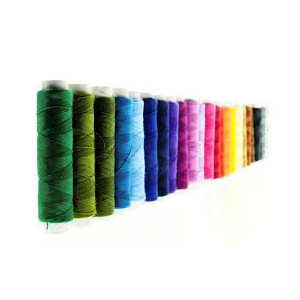For in-depth knowledge about the whole concept of sewing, one must also be aware of the related facts and information. The entire mechanism of sewing is not a very easy concept. Through the years, the techniques have evolved, and with innovations, regular sewing has become much more convenient.
Let’s take a look at the various sewing facts and their required peripherals to get you more inclined to this fascinating craft.
Sewing Machines
 Singer is not the inventor of the sewing machine. He developed a device of his version based on the designs of others and modified it accordingly. He later patented it under his name. His company, by the name “Singer” became one of the highest numbers of the producer of sewing machines.
Singer is not the inventor of the sewing machine. He developed a device of his version based on the designs of others and modified it accordingly. He later patented it under his name. His company, by the name “Singer” became one of the highest numbers of the producer of sewing machines.
President Ronald Reagan marked September as the National Sewing Month in the year 1982. It was to encourage and provide recognition for home sewing. Every year the whole month, witnesses the bloggers, retailers, and individuals share a common platform and exchange ideas for strengthening the bond with stitching.
With the modernization of technology, the early versions of sewing machines operated by hand or foot revolutionized. It gave birth to the electric sewing machines in the year 1889. They became a trend by the 20th century that almost every household had one device.
Till the 20th century, with the development of more than 4000 varieties of sewing machines, the entire technology was modified. Most of the versions are no longer available because of the technical problems and were not user-friendly.
Sewing Needles
 Hand sewing was the only option before the invention of machines. Studies suggest that early needles were either made of bone, ivory, fish bones or wood
Hand sewing was the only option before the invention of machines. Studies suggest that early needles were either made of bone, ivory, fish bones or wood
The needles had split heads, which is now the eye of the modern needle.
The oldest discovery of needle made of bone was from 61000 years ago.
In due course of time, needles were made of bronze and later with steel.
For the prevention of corrosion, most of the needles found today have a coating of nickel or gold.
They are available in different sizes and have different uses per the fabric needed in the sewing project.
Buttons
 The earliest button found in Pakistan was of the shell. It is expected to date back to about 5000 years.
The earliest button found in Pakistan was of the shell. It is expected to date back to about 5000 years.
Earlier, the usage of buttons was in the form of ornamentation. Later, in the 13th century, buttons and its buttonholes were used as fasteners.
During World War I and World War II, manufacturing lockets with buttons were in demand to keep compasses in it for the army.
In women’s outfits, the buttons are on the left-hand side. It is because making the tasks more manageable for the maids of wealthy women helped to dress them up during the earlier years.
As per word of mouth, it is a rumor that Napoleon, during his rule, ordered for buttons on sleeves of the uniform of soldiers, to avoid them to wipe their noses with sleeves.
Thread
 Earlier, thin strips of animal skin were for stitching.
Earlier, thin strips of animal skin were for stitching.
The spinning of thread and its various colors developed simultaneously with the advancing civilizations.
Egyptians used animal wool and hair for spinning, and the inhabitants of Phoenicia developed the colors and dyes from berries and other flowers.
The extraction of cellulose from plants is the ingredient for the preparation of cotton threads.
Do not ever buy poor and cheap quality thread; it will slowly and gradually harm the sewing machine.
For a perfect match of thread on the fabric, choose one shade darker.
Thread is used for sewing garments, while it might seem similar, but the yarn is for weaving into fabric.
Fabrics
 The earliest data of fabric is a belief to be used in 5000BC. During this time, flax, a natural matter, was used for making linen.
The earliest data of fabric is a belief to be used in 5000BC. During this time, flax, a natural matter, was used for making linen.
As per manifestation, with the use of cotton and wool were natural fabrics were made in 3000 BC.
The largest manufacturer of silk is China in the last 100 years and still going strong. They are also the highest exporter of this delicate material.
The first human-made fiber was invented in 1910 by Rayon.
Egypt develops the best quality of cotton.
Other Sewing Facts
Apart from the facts on the background and other interesting information about sewing, a beginner in this field must also keep in mind a few details. It will help in avoiding silly mistakes and learn some necessary skills.
Many parts of a respective sewing machine are not compatible with another device of a different brand. Such as the bobbins and the presser feet. Use the same components for the same sewing machine as it was during the time of purchase.
Sewing machines do not have any such setting that will allow self-cleaning. So, manual cleaning is a must to extend its longevity.
The quality of a sewing machine does not depend on the price of purchase. But it does depend on the features, settings, and accessories.
Before beginning to learn how to sew, one must learn the sewing patterns and the various parts of a sewing machine.
While sewing, to keep the seam inside the garment, follow the right sides together.
After every five to six hours of continuous usage, replace your needles.
Sewing Facts: Final Thoughts
Sewing machines and other required materials are readily available either in local stores or online sites. But this was not the case a few years back. Thus, it is interesting to know the sewing facts about its origin and its evolution in due time. Sewing as a beginner in its initial stage might be frightening and pressurizing, but the skills of a craft do not come easily.
For achieving abilities, it is necessary to learn the basics and then move forward with patience. Along with practical knowledge, it is essential to know the theory about the subject as well. A combined idea of both will surely turn you to a creative dressmaker or a sewing specialist who will lead towards more significant projects in the future with excellence


